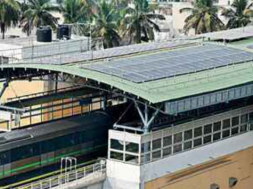

BENGALURU: In what could be a significant step towards eco-friendly mass transit, Bangalore Metro Rail Corporation (BMRCL) is planning to harness solar power to run its trains.BMRCL is looking to install solar panels in all phase 2, 2A and 2B Metro stations by March 2023.
At present, solar panels are installed in five stations — Konanakunte Cross, Doddakallasandra, Vajarahalli, Talaghattapura, and Silk Institute on Kanakapura Road Metro corridor (Green Line extension, Yelachenahalli-Silk Institute).
While solar energy cannot be harnessed in stations on Metro phase 1, which is already operational, BMRCL chief PRO BL Yashwanth Chavan said, “We are planning to install solar panels in all phase 2, phase 2A and phase 2B stations”
Cutting down power bills
Metro uses a third-rail system that provides electric traction power to trains. Officials said a major share of power required for the third rail and auxiliary requirements such as lighting, escalators and AC at stations will be met through solar energy.
“The current monthly power requirement for the third rail alone is around 65 lakh units (kWh) for the 56km operational network. The estimated monthly requirement will be 205 lakh units once phase 2, 2A and 2B (175km) are completed,” Chavan said. He added that the current monthly power expense for third rail alone is around Rs 3.9 crore. BMRCL now generates 1.8 lakh units through solar panels and saves Rs 10.8 lakh a month.
BMRCL is also hoping the reduced dependency on non-renewable sources will cut down its energy bills. “BMRCL’s monthly electricity bill now is around Rs 5.8 crore. The estimated bill after the commissioning of phase 2, 2A and 2B is Rs 19 crore. The estimated monthly solar power generation is 28.5 lakh units by 2023 (excluding phase 2A and 2B). This will reduce our bill by around Rs 1.7 crore by March 2023,” Chavan said.
Trains tap into own energy
Trains also use regenerative braking system technology to generate power every time brakes are applied. The three-phase traction motors in trains act as generators whenever brakes are applied, turning the kinetic energy of the train into electrical energy.
“At present, trains meet around 15% of the power needs (lighting and running auxiliary systems onboard) on their own. We are now working on a technology to ensure power generated by trains is completely used and transferred to the grid so we can reduce dependency on power supplied by Bescom,” Chavan said.
All stations are designed to utilise natural lighting and are equipped with LED-based lights, another official said, adding that BMRCL will install platform screen doors (PSDs) at phase 2 underground stations (14km Dairy Circle-Nagawara) that will reduce the AC load from 900T to 400T per station.
Source: PTI














